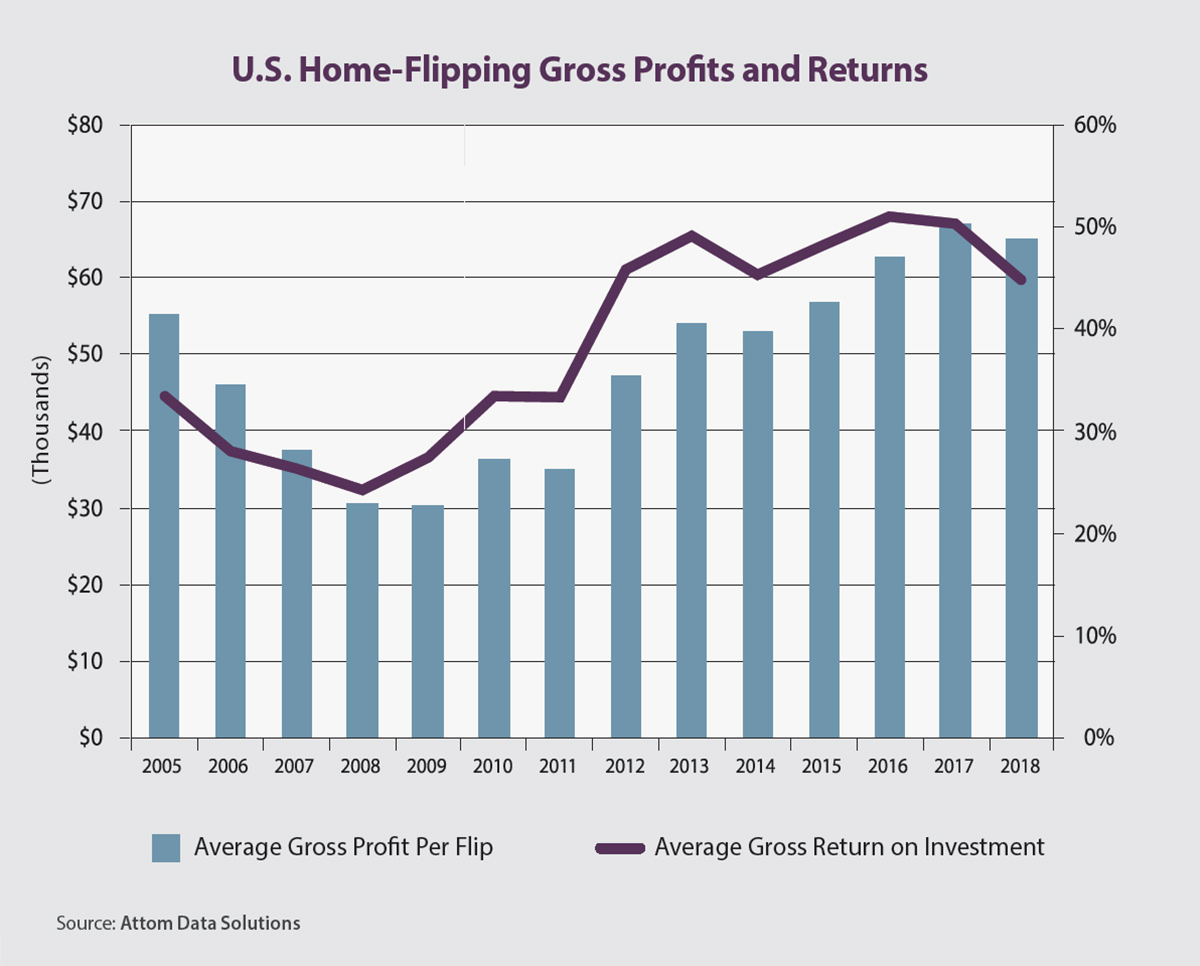Although the appetite for home flipping remains relatively steady, the market is beginning to cool. In 2018, there were 207,957 single-family homes and condominiums flipped in the U.S., according to Attom Data Solutions’ Year-End 2018 U.S. Home Flipping Report. This is a 4 percent decrease from the 216,537 flips seen in 2017, although the market share of flips among all home sales remained at 5.6 percent in both 2017 and 2018.
The slowdown in flips is the natural result of the overall stabilization of the real estate market. Mortgage rates remain historically low, and many people are electing to remain in their homes longer than historical averages. Several U.S. markets, however, are still seeing high rates of flips, particularly those areas with some of the lowest prices in the country. According to Attom Data’s analysis of 53 metro areas with at least 1 million people, the highest home-flipping rate this past year was in Memphis, Tennessee, where 11.7 percent of all home sales were flips. Phoenix (9.1 percent); Las Vegas (8.7 percent); Tampa- St. Petersburg, Florida (8.2 per- cent); and Birmingham, Alabama (7.6 percent) rounded out the top five.
Some of the largest increases in home-flipping rates, however, came from surprising sources in 2018. The Boston metro area has some of the highest-priced real estate in the country, but it saw the biggest increase in home-flipping rates in 2018 with a jump of 33.3 percent. Tucson, Arizona, was next in line with an increase of 27.3 percent, followed by Raleigh, North Carolina (24.5 percent), and Columbus, Ohio (13.1 percent).
Although home flipping is often an all-cash investment, lending volume for home flips increased 7.6 percent in 2018 to an 11-year high of nearly $20 billion, up from $18.6 billion in 2017. Despite the increase in volume, however, the overall percentage of flipped homes purchased by an investor with financing decreased to 39.1 percent in 2018, a slight dip from the 39.4 percent recorded in 2017. Financing of flips continues to level out from the troughs of 2010 and 2011, when less than a quarter of all flips were financed.
Increased lending volume is likely a result of the overall market trend of higher home prices across the board. The median purchase price of a flip increased from $133,000 in 2017 to $145,000 this past year. And the median sales price (after repairs) increased as well, from $199,900 in 2017 to $210,000 in 2018. Completed home flips this past year had an average gross profit of $65,000, a 2.8 percent decrease from the average gross profit of $66,900 in 2017. In 2018, the average gross flipping profit represented an average return on investment (ROI) of 44.8 percent, a decline from the 50.3 percent ROI seen in 2017 and a seven-year low.
Unsurprisingly, the areas with the greatest returns on investment were in markets with still-depressed prices. Among major metro areas with at least 1 million people, the highest average gross flip ROI was in Pittsburgh (144.2 percent), followed by Cleveland at 112.1 percent, Philadelphia at 109 percent and Baltimore at 103.5 percent.
Flipping remains a viable investment for many, but recent trends seem to indicate that the market is leveling off and the ROI peaks of 50 percent or more may be in the past — depending on the market, of course. Certain areas of the country are still ripe for investment and may yet yield significant returns for investors for years to come. In fact, 25.3 percent of flipped homes in 2018 were sold to all-cash buyers — often other real estate investors — which may indicate that some investors see even greater potential ahead.
Author
-

Todd Teta is chief product and technology officer at Attom Data Solutions, where he leads the company’s technology and product teams. Prior to joining Attom Data Solutions, Teta led the product-development and technology organization at Meyers Research. Teta also previously co-founded several startups, including VisionCore, a company serving the mortgage and real estate data and analytics markets that was later sold to CoreLogic. He is a graduate of the University of Southern California, where he earned a degree in computer engineering and computer science. Learn more about Attom Data Solutions at attomdata.com.
View all posts







